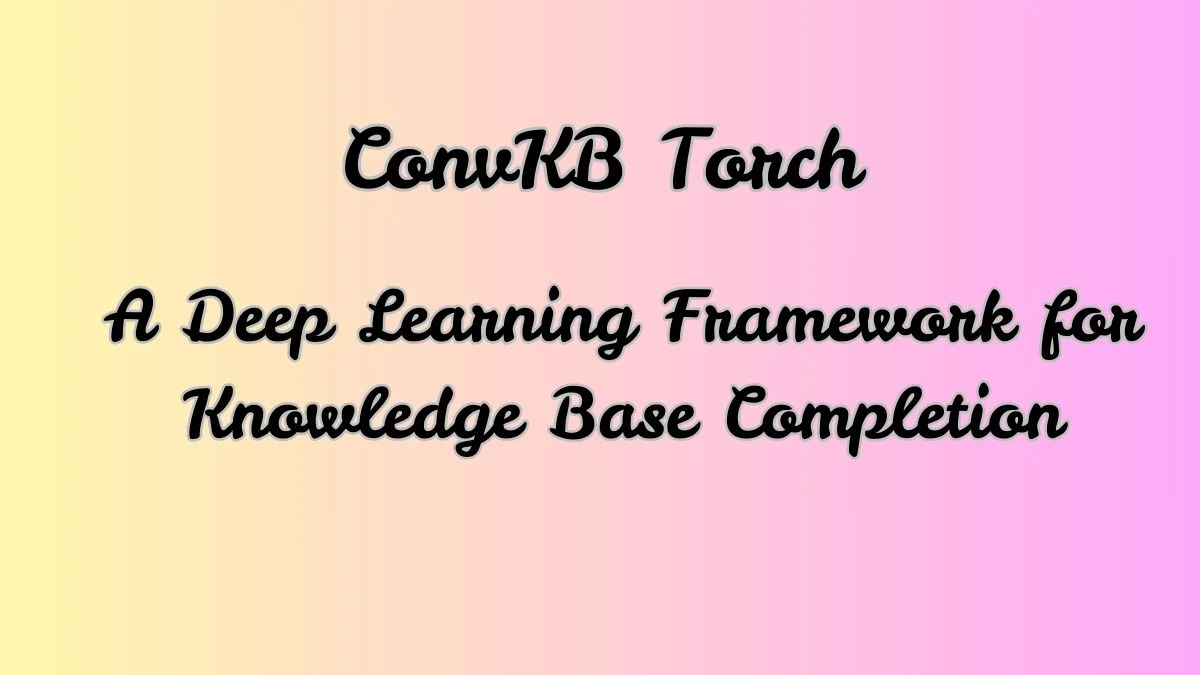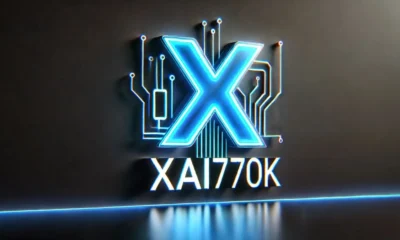GENERAL
ConvKB Torch: A Deep Learning Framework for Knowledge Base Completion

The advanced framework ConvKB Torch unites the CNN-based knowledge base completion model ConvKB with the machine learning library Torch (or PyTorch). Knowledge base completion (KBC) behaves as an essential artificial intelligence component which strengthens data representation while producing better predictions and advancing relational knowledge acquisition. The convolutional neural network layers in ConvKB extract larger features from embeddings thereby surpassing traditional KBC systems TransE or DistMult. Through the integration with PyTorch this tool provides developers and researchers with essential features for efficient training and flexibility and scalability.
Understanding Knowledge Base Completion (KBC)
KBC is a method used to fill missing facts in a knowledge graph by predicting new relationships between entities. Traditional knowledge bases, such as Google Knowledge Graph, Wikidata, and Freebase, often contain incomplete data, which limits their effectiveness. KBC models, including ConvKB, aim to resolve this issue by leveraging deep learning to infer missing links based on existing facts. ConvKB uses CNNs to capture contextual information, unlike conventional translation-based models that rely on simple vector transformations. This makes it a powerful alternative for applications in semantic search, recommendation systems, and AI-driven decision-making.
What is ConvKB?
ConvKB is a convolutional neural network (CNN)-based model designed to improve knowledge graph embeddings. It works by applying convolutional filters over entity-relation triples (head entity, relation, tail entity) to extract local features and identify meaningful patterns. Unlike traditional KBC models like TransE, which assume fixed vector translations, ConvKB learns non-linear interactions between embeddings, leading to more accurate link predictions. The CNN layers help capture deeper relationships in the data, making it more robust in handling complex knowledge bases. This enhanced approach ensures that even subtle connections between entities are recognized, leading to better reasoning and inference.
Torch and PyTorch: The Backbone of ConvKB Torch
PyTorch is a dynamic deep learning framework widely used in research and production. It provides easy-to-use APIs, GPU acceleration, and a strong community. Torch, the earlier version, laid the foundation for deep learning with Lua but was later replaced by PyTorch, which offers Python support. ConvKB Torch leverages PyTorch’s automatic differentiation, efficient tensor computation, and modular neural network design. This enables seamless implementation of ConvKB’s CNN layers, making training and optimization straightforward. PyTorch’s scalability and flexibility allow developers to experiment with different architectures, making it ideal for implementing state-of-the-art KBC models.
ConvKB Torch Architecture and Workflow
The architecture of ConvKB Torch consists of the following key components:
- Embedding Layer: Converts entities and relations into dense vector representations.
- Convolutional Layer: Applies CNN filters to extract meaningful patterns from entity-relation triples.
- Fully Connected Layer: Aggregates CNN outputs and learns higher-level representations.
- Scoring Function: Assigns a confidence score to each predicted relation, determining the likelihood of a fact being true.
How to Train a ConvKB Torch Model
Training a ConvKB Torch model requires:
- Dataset Preparation: Load a knowledge graph dataset (e.g., FB15k-237, WN18RR).
- Model Training: Use CNN layers to learn entity-relation patterns.
- Hyperparameter Tuning: Adjust parameters like learning rate, batch size, and convolutional filter sizes.
- Evaluation: Validate performance using metrics like Mean Reciprocal Rank (MRR), Hits@N, and Mean Rank.
A properly trained ConvKB Torch model can accurately predict new knowledge graph facts with high precision.
Performance Metrics for ConvKB Torch
Evaluating ConvKB Torch involves several key metrics:
- MRR (Mean Reciprocal Rank): Measures ranking quality of predicted relations.
- Hits@N: Checks if the correct entity appears in the top N predictions.
- Mean Rank: Computes the average ranking position of correct entities.
ConvKB Torch generally outperforms traditional models, offering improved generalization and robustness in large-scale knowledge bases.
Applications of ConvKB Torch in AI and Machine Learning
ConvKB Torch has numerous applications, including:
- Search Engines: Enhancing semantic search and query understanding.
- Recommendation Systems: Predicting user preferences based on existing relationships.
- Biomedical Research: Discovering new drug interactions from existing medical databases.
- Cybersecurity: Identifying suspicious patterns in network logs.
Its versatility and accuracy make it a valuable tool across industries.
Comparison with Other KBC Models
ConvKB Torch vs. Other Models:
- TransE: Uses vector translation, less flexible than ConvKB.
- DistMult: Captures symmetric relations, limited expressiveness.
- ConvKB: CNN-based, extracts richer features, better accuracy.
ConvKB Torch is more advanced due to its ability to capture complex relationships using convolutional layers.
Challenges and Limitations of ConvKB Torch
Despite its advantages, ConvKB Torch faces challenges such as:
- High Computational Costs: Training CNN-based models requires significant GPU power.
- Data Quality Issues: Incomplete or biased knowledge bases can impact performance.
- Limited Interpretability: Understanding CNN-based predictions can be complex.
Overcoming these limitations requires efficient resource management and high-quality training data.
Optimizing ConvKB Torch for Better Performance
Enhance ConvKB Torch’s performance by:
- Using Larger Datasets: More data improves generalization.
- Fine-Tuning Hyperparameters: Optimizing learning rates and batch sizes.
- Implementing Advanced Regularization: Reducing overfitting with dropout and batch normalization.
These techniques can significantly boost model accuracy and efficiency.
Future Trends in Knowledge Base Completion and Deep Learning
- Graph Neural Networks (GNNs): Integrating GNNs with ConvKB for better reasoning.
- Self-Supervised Learning: Training models with minimal human intervention.
- Scalable AI Architectures: Enhancing real-world applicability of knowledge graphs.
These advancements will shape the future of automated knowledge discovery.
Conclusion
ConvKB Torch is a powerful AI tool for knowledge base completion, combining CNN-based learning with PyTorch’s efficiency. It outperforms traditional models, making it ideal for large-scale AI applications in search, recommendations, and cybersecurity. While challenges like computational demands exist, optimization techniques and future advancements promise greater efficiency and accuracy. ConvKB Torch represents the next step in intelligent knowledge inference, paving the way for more sophisticated AI-driven insights.
-

 BIOGRAPHY5 months ago
BIOGRAPHY5 months agoBehind the Scenes with Sandra Orlow: An Exclusive Interview
-

 HOME11 months ago
HOME11 months agoDiscovering Insights: A Deep Dive into the //vital-mag.net blog
-

 HOME1 year ago
HOME1 year agoSifangds in Action: Real-Life Applications and Success Stories
-

 BIOGRAPHY12 months ago
BIOGRAPHY12 months agoThe Woman Behind the Comedian: Meet Andrew Santino Wife




























